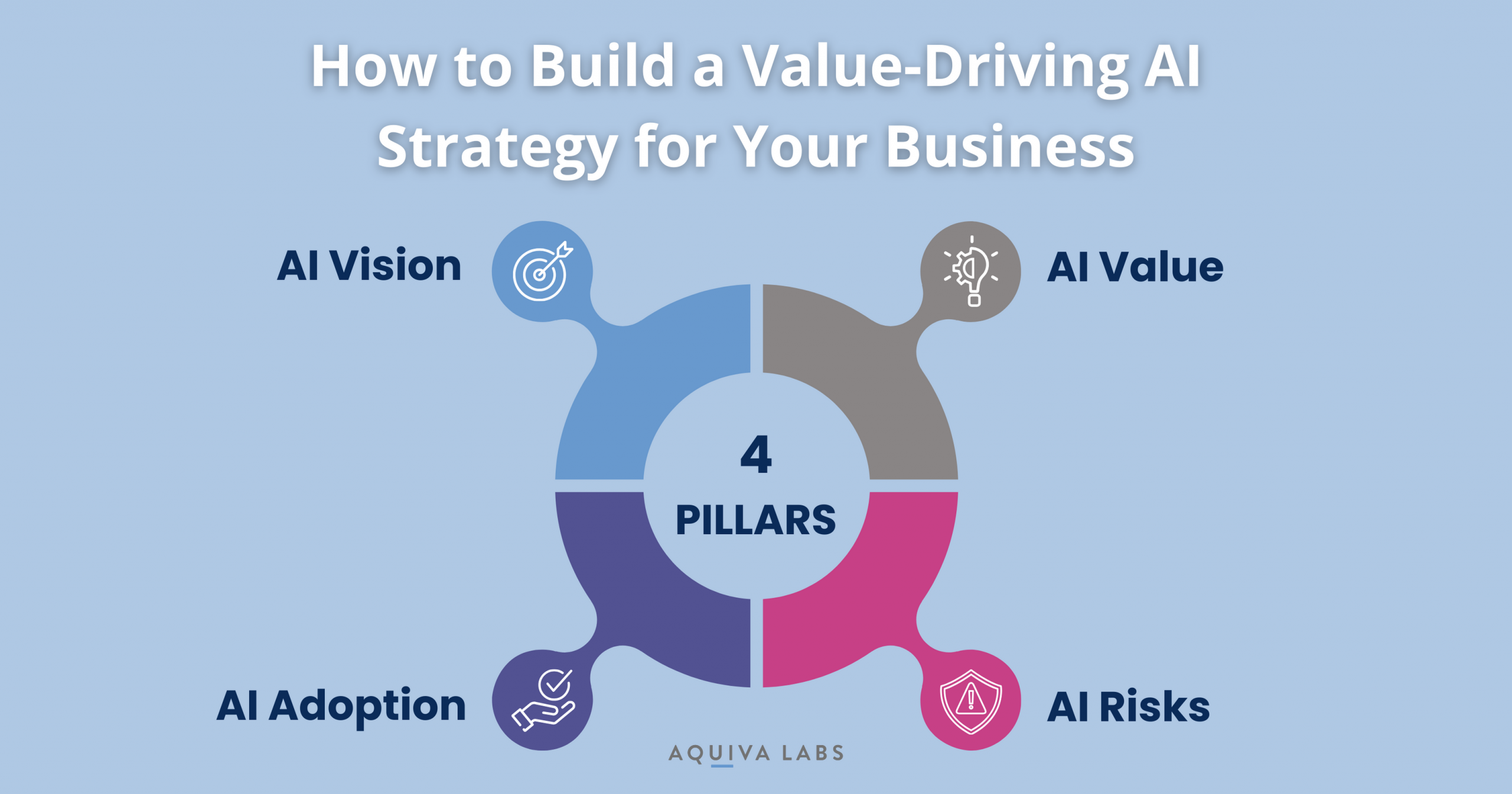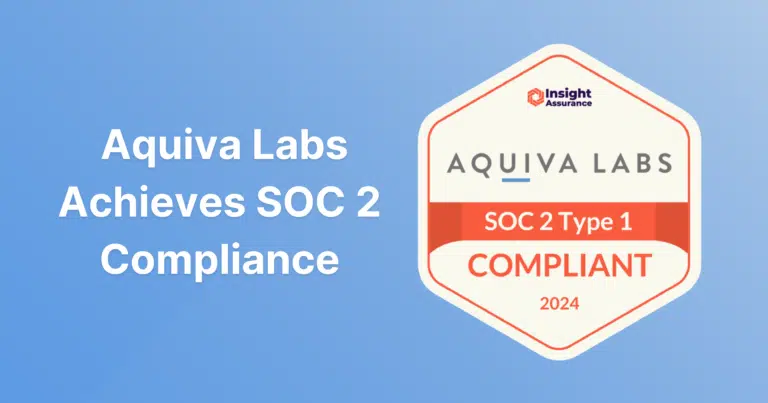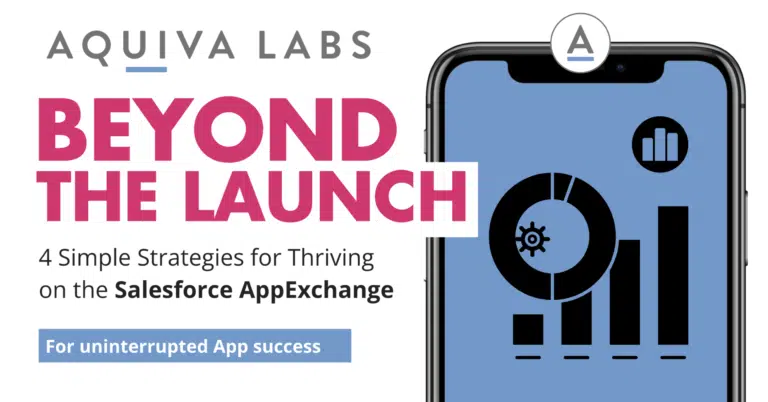At Aquiva Labs we’ve spent the last couple of years helping organizations build AI-powered products and share AI strategies related to their internal usage of Salesforce. Last year has been a true accelerator due to the LLM-related boom. It won’t come as a surprise to anyone that businesses are increasingly recognizing the imperative need to integrate AI strategies into their operational fabric. As AI becomes more accessible and powerful, the question shifts from whether to adopt AI to how to do so effectively. The key to unlocking AI’s potential lies in building a strategy that drives value while managing risks and ensuring seamless adoption.
The Four Pillars of AI Strategy
A robust AI strategy should stand on four critical pillars: Vision, Value, Adoption, and Risks. Each of these pillars plays a pivotal role in guiding businesses through the complexities of AI integration and ensuring that AI initiatives align with broader business goals.
1. AI Vision: The Foundation of Strategy
The vision for AI within your company sets the stage for all subsequent decisions. Your vision should identify the strategic opportunities presented by AI, and how these align with your broader business goals. You don’t need to do this alone – Salesforce consulting partners like Aquiva Labs can provide a roadmap for successful AI integration, demonstrating how AI can serve as a competitive advantage by automating tasks, generating insights, and innovating processes.
2. AI Value: Beyond Technology
Capturing AI’s value requires a holistic view that goes beyond technology. It involves understanding the impact of AI on business processes, employees and customers, and the overall organization operations. Effective AI solutions should not be one-off implementations but rather integrated elements of broader business operations, capable of scaling and adapting as the business evolves.
3. AI Risks: Navigating the Challenges
With AI adoption comes a spectrum of risks – regulatory, reputational, and competencies. Awareness and preparation for these risks are crucial. This includes staying abreast of evolving AI regulations, building robust systems to prevent bias and data breaches, and continuously developing the required skill sets within the organization.
4. AI Adoption: The Path to Success
The successful adoption of AI hinges on carefully selecting use cases based on their business impact and feasibility. Prioritizing AI projects that align with business goals and are technically and culturally feasible ensures a smoother integration and greater value realization. Think about desirability, feasibility, viability and scalability. Desirability reflects the alignment with customer/business needs, feasibility related to the technical and logistical capabilities of integrating AI, viability considerations the economic sustainability and scalability addresses the ability to pivot and expand as the business grows.
Executing a Value-Driving AI Strategy
To translate these pillars into action, your business should:
- Set Clear Goals: Define specific, measurable outcomes that AI initiatives should achieve, linking these to broader business impacts.
- Benchmark and Measure Success: Adopt a metric-driven approach to evaluate the effectiveness of AI initiatives, focusing on business growth, customer success, and cost-efficiency.
- Select the Right Tools: In the context of Salesforce, Einstein 1 Platform and the broad range of Einstein products might be the obvious choice. However, many use cases will require you to look broader at adoption of the AI tools beyond Salesforce and custom build.
- Plan for Organizational Change: Prepare for the transformative impact of AI on organizational structures and processes, ensuring that teams are equipped with the necessary skills and resources.
- Prioritize Trust and Transparency: Address data security, privacy, and ethical concerns upfront, building trust in AI solutions among stakeholders.
The Role of Experimentation in AI Strategy
Before fully committing to an AI strategy, many businesses engage in experimentation. At Aquiva, we spent the whole year experimenting internally and with our customers, building applications such as Ask Your Document and implementing LLMs into Kaptio’s solution for Tour and Cruise Operators to understand the full potential and capabilities of various LLMs. The experimentation approach involves identifying impactful use cases, assembling the right skills, gathering relevant data, selecting the right tech stack, and structuring the organization accordingly. This step-by-step process ensures a quick time-to-value and lays the groundwork for a more strategic, long-term AI vision.
Conclusions
Building a value-driving AI strategy is not a one-size-fits-all endeavor. It requires a nuanced understanding of the organization’s unique needs, goals, and challenges. By focusing on the four pillars of Vision, Value, Adoption, and Risks, and by embracing an agile approach to implementation, you can harness the transformative power of AI to drive growth, innovation, and competitive advantage in an increasingly digital world. Reach out to Aquiva to understand how we can guide you in creating an AI strategy that helps you unlock value and drive growth and operational excellence.
Written by:

Greg Wasowski
VP, Solution Consulting




